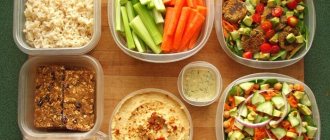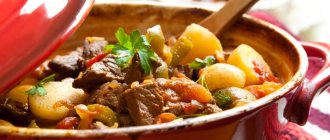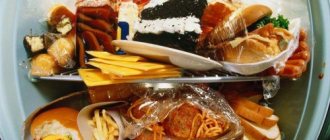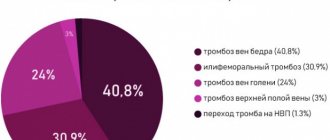According to statistics from the Ministry of Health of the Russian Federation, more than 43% of Russians suffer from hypertension and have high blood pressure¹. In turn, the World Health Organization recalls that cardiovascular diseases are one of the leading causes of death in the world.
The DASH diet is a nutrition system for hypertensive patients, developed by doctors. It is based on limiting salt and saturated fats in the diet - key causes of high blood pressure. What is allowed to eat and what is forbidden? Menu by day for the week.
What is the dash diet?
DASH is actually an English acronym. It consists of the words Dietary Approaches to Stop Hypertension, which means “Dietary approach to prevent hypertension.” I’ll tell you what it is in more detail.
Initially, it was a diet developed for hypertensive patients.
At the same time, the “side effect” of the special system is weight loss, and this is its huge advantage. After all, high blood pressure often comes as a result of gaining excess weight. The effectiveness of the diet is also expressed in the following points:
- heart function improves;
- the level of bad cholesterol decreases;
- metabolism is activated;
- the body is cleansed;
- the system acts as a prevention of hypertension, which is extremely dangerous to health and life;
- it also prevents diabetes, problems with blood vessels and heart muscle, kidney diseases and even cancer.
An important difference between the system and many others is that it does not force you to starve, and does not give many harsh taboos.
At the same time, it reduces blood pressure, normalizes weight, and significantly improves well-being. The nutrition system is universal and is also suitable for men of any age.
Judge for yourself how relevant this is. So, according to WHO, over the past 40 years the number of hypertensive patients has doubled. But according to statistics from the same organization for 2021, the number of people on the planet suffering from high blood pressure has crossed the 1.1 billion mark.
But that's not all. According to the most conservative estimates, by 2025 there will already be one and a half billion such sufferers! In Russia, 40% of the adult population experience problems with high blood pressure in one way or another. At the same time, hypertension is gaining momentum among children and adolescents.
To date, this disease has been found in 3.5% of the younger generation.
The heart and more
Research shows that the DASH diet helps prevent the development of cardiovascular disease and normalize blood pressure in hypertension and pre-hypertension. By following it, you can reduce both systolic and diastolic pressure, and the changes are noticeable quickly: in the first week you can reduce the value by 1-4 mm Hg. Art.
How much your blood pressure will decrease depends on several factors.
- The higher the pressure ,
the more pronounced the effect. - Physical activity, salt and calorie restriction give better results.
But is there any benefit from DASH if you don't have high blood pressure? Definitely, since a nutrient-dense diet with an emphasis on plants and unsaturated fats is good for everyone
, and not just those who already have heart problems. First of all, it is useful for the prevention and correction of diseases that often accompany hypertension.
Thus, diabetes often goes hand in hand with hypertension. Metabolic syndrome is called prediabetes.
, which precedes type 2 diabetes. It is not a disease itself, but a set of diagnostic indicators: obesity, excess abdominal (abdominal) fat, low insulin sensitivity, high levels of triglycerides, very low-density lipoproteins and sugar, and low levels of “good” HDL cholesterol in the blood. DASH can help with this condition, as it consistently improves all indicators characteristic of metabolic syndrome.
How exactly does this happen? Most likely, all components of the diet have their own role in the process.
, each of them enhances the effect of the others, and together they work better than, for example, giving up sweets or limiting trans fats and fats separately. So, the diet is low in sugar, but high in fiber, which slows down the absorption of sugar and increases insulin sensitivity → better insulin sensitivity helps cope with both high blood sugar and excess belly fat → limiting trans fats and saturated fats reduces the amount of “bad” » cholesterol and triglycerides in the blood → which also helps get rid of excess fat.
It's no surprise that DASH also helps you lose weight
. Eliminating sweets and fatty foods from your diet is enough for some people to automatically consume fewer calories and lose weight. However, most people still need control and caloric restriction to lose weight. This is where DASH has an advantage: It is associated with greater weight loss than other calorie-restricted diets. It is interesting that in this case it is the fat mass that is reduced, while the muscle mass is preserved.
For example, in a small study, half of the obese participants ate a calorie-restricted DASH diet, while the other half followed a “regular” calorie-restricted diet. The calorie intake for each participant, regardless of the group, was calculated individually: scientists created a deficit of 350 to 700 kcal, depending on the initial BMI. The ratio of protein, fat and carbohydrates in the diet was also the same, but participants in the “DASH group” got their calories and macronutrients from whole grains, low-fat dairy products, vegetable oils, nuts, and lean meats. And the control participants were made from “ordinary” products for which there were no special requirements; they just had to meet your daily caloric intake and protein/fat/carbohydrate ratio.
Over eight weeks, those participants who ate the DASH system lost an average of 3.5 kg more. They also had improved biomarkers
metabolic inflammation and oxidative stress in the blood: triglyceride and cholesterol levels decreased and total plasma antioxidant activity and glutathione levels increased.
There is also evidence that DASH is associated with a lower risk of all types of cancer, but particularly colorectal, colon and rectal cancer, as well as kidney disease, depression and insomnia, but these “side effects” of the hypertension diet are less studied. DASH is not a magical diet, but simply healthier than the average person's diet, which is why it has so many non-heart-protecting benefits.
MIND Diet
a variant of DASH with elements of the Mediterranean diet, is designed to protect the brain from cognitive impairment, as indicated by the name of the diet: Mediterranean-DASH Intervention for Neurodegenerative Delay.
Although the overall evidence base for MIND is weaker than that of its parents, some studies suggest it is more effective in reducing the risk of neurodegeneration
. Its benefits extend to reducing the likelihood of developing Alzheimer's disease, as well as slowing the progression of Parkinson's disease.
At the same time, MIND allows greater liberties than nutrition according to the DASH rules. Thus, one serving of red wine per day is not only allowed, but is considered beneficial - wine contains resveratrol, which, according to some data, can somewhat slow down the progression of Alzheimer's disease. Resveratrol is also found in grapes, some berries, cocoa and peanuts.
Main advantages of the system
This diet has the following important benefits:
- It is accessible to everyone, as it does not include delicacies and expensive products.
- Normalization of blood pressure and weight occurs without the feeling of hunger, and nutrition remains adequate;
- The menu is rich in health benefits and contains all the necessary vitamins and microelements.
- It is simple and convenient to use, and there is no need to count calories.
- Promotes weight loss and prevents many serious ailments.
- The condition of hair, dermis, and nails improves.
- The result in the form of normalization of blood pressure and good health appears quite quickly.
Advantages and disadvantages
The therapeutic DASH diet has many advantages, it is very beneficial for the health of any person. Its main advantages:
- Suitable for everyone.
- Helps normalize blood pressure and cholesterol levels without medications or with a minimal amount of them.
- Promotes safe weight loss and prevention of diseases associated with excess weight. Provides long-term results.
- The DASH diet is satisfying and is not accompanied by a constant feeling of hunger.
- Helps a person switch to proper nutrition and get rid of bad eating habits.
- Does not require significant financial costs.
Like any diet, DASH has its downsides. Disadvantages of this power system:
- Many people find it very difficult to give up salt and foods containing it, and sweets.
- The body needs some time to adjust to a new regime.
- The result is not immediately noticeable.
- You need to get used to the fact that you have to cook everything yourself and regularly devote time to it. Eating fast food and processed foods is prohibited.
Basic rules of the dash diet
Below, dear readers, you will find a list of the rules of the dasha system:
- a taboo is placed on baked goods, store-bought sweets, everything smoked, fries, highly salted, as well as fast food;
- salt consumption should be reduced to 1/3 teaspoon per day;
- the main products in the diet are vegetables, a variety of cereals, fruits, fish, berries, any lean meat, exclusively whole grain bread, low-fat milk, legumes;
- alcohol and smoking are also taboos;
- There is a minimum of animal fats; they are replaced with vegetable oils.
Where to start - tips for beginners
A few days before starting the Dash diet, it is advisable to keep a notebook in which to write down everything that was eaten for breakfast, lunch, dinner, and also in between meals. By analyzing the records, it is easier to make adjustments to the menu, gradually replacing your favorite dishes until they fully comply with the principles of the blood pressure diet. As you can see, you don’t have to suddenly start changing your habits and life. Here are some examples of tips that will help you change your diet:
- There are few vegetables in the diet, add one serving for dinner or lunch;
- no fruits, add them to your snack between lunch and dinner;
- When reading the composition of products, choose those that do not contain preservatives, dyes or flavors;
- gradually introduce dairy products with a low fat content - kefir;
- replace instant cereals with whole grains;
- in winter, use frozen vegetables, fruits, berries;
- add nuts, seeds and legumes to your menu.
And also read on our website: How honey affects a person’s blood pressure: increases or decreases, as well as its effect on blood vessels and the heart
However, this is not all the recommendations. When switching to the Dash diet for hypertension, you should simultaneously begin to reduce the caloric content of food, for this:
- eat more fruits instead of the usual sweets. This will save 200 kcal;
- use vegetables as a side dish - 50 kcal;
- low-fat or low-fat foods will reduce calorie content by 70 kcal.
You can reduce calorie content by changing portion sizes, using smaller plates and drinking up to 1.5 liters of water throughout the day.
Dash diet for hypertension
The menu for hypertensive patients is designed in a special way that it contains a lot of food high in calcium, plant fiber, potassium, magnesium, other extremely important microelements, as well as pure protein. All this normalizes the most important processes in the body and improves the condition of everyone, not just people with high blood pressure. Actually
The dash diet is a direct dietary treatment for a disease such as hypertension. Moreover, it is affordable, effective, with a “side effect” in the form of weight loss.
Here are additional tips for patients with this problem:
- limit even healthy sweets - eat them no more than 4 times a week;
- eat fish or lean meat every day (2 modest servings);
- also – 2 servings of milk per day;
- vegetables and unsweetened fruits – 5 times a day;
- cereals - every day.
Grocery list
Allowed
- fruits of the legume and cereal family;
- vegetables and fruits;
- nuts, seeds;
- dairy products with a fat content of no more than 1.5%;
- lean meat, fish and seafood;
- bread: rye, whole grain, yeast-free, with bran;
- lemon juice, mustard, vinegar in the form of spices and salad dressings.
Prohibited
- alcohol and carbonated drinks;
- marinades and pickles;
- fatty dairy products;
- fatty meat, sausages, lard, canned food, smoked food;
- fatty fish;
- cheeses;
- baked goods, wheat bread;
- sugar and sweets;
- fast food and semi-finished products;
- coffee and cocoa.
Limit consumption
- salt and spices;
- of bread;
- butter;
- fish eggs
Dash diet for weight loss
In fact, the energy value of the diet of this system is about 2000 kcal per day.
At the same time, it gives everyone who adheres to it the opportunity to lose weight correctly! That's right - this means gradually, without hunger and harm to the body.
Of course, the dash diet was not developed specifically for weight loss, and this should be taken into account by those who choose it. But losing weight is an excellent “side effect”, because the antihypertensive effect of weight loss in almost all hypertensive patients has been proven by scientists.
Moreover, there is a clear correlation between minimizing weight and a sustainable decrease in pressure, that is, the proportion is 1 kg/1 mm Hg. Art.
Dash diet in video story:
What you can and cannot eat
You should buy less meat, eat it at a maximum of 200 g per day (reduce the usual large portion by two or three times). Two days a week should be completely vegetarian, with more legumes, grains (such as rice), fruits and vegetables included in the diet. If a person loves casseroles and pates, then to prepare them you need to use more vegetable ingredients and cereals.
During snacks, you can eat fresh or canned fruits in their juice, unsalted pretzels, sour milk, nuts, and reduced-fat yogurt. Main meals containing meat and fish should be cooked by steaming, boiling or baking in the oven. During cooking, you should not use vegetable oils; they can only be used to season salads.
List of prohibited products:
- semi-finished products;
- cakes, straws, cookies with a lot of sugar, salt and custard;
- chocolate, chips, crackers;
- fried and fatty foods;
- strong tea and coffee;
- sour cream, cream, full-fat dairy products.
To quench your thirst, freshly squeezed juices, compotes of fresh and dried fruits, clean water, and weakly brewed cold green tea are suitable. Carbonated drinks are prohibited. A feature of the Dash diet is that food is consumed in portions, with one portion being the amount of food that fits into a person’s palm. Liquid foods are measured in half a glass (for example, soup or porridge), and the second - half a glass of boiled cereal.
Every day, the diet of a person suffering from hypertension should include the following products:
- 4 cups of pasta or cereal in the form of porridge;
- 5 cups of fresh fruits and vegetables;
- meat or fish in the amount of 200–300 g;
- 3 tbsp. l. vegetable oil, preferably olive;
- 3 cups low-calorie kefir or low-fat yogurt;
- seeds or nuts no more than 100 g per day.
Cooking by stewing requires the addition of oil, and the amount of product already used must be taken into account. If 3 tablespoons of oil are allowed per day, then there will be one left to eat in its pure form after cooking. Porridge can be consumed from any grain, as long as the serving size is not exceeded. Vegetables can be eaten fresh or cooked by baking. If meat or fish is consumed, then this meal should be the main meal, and not fall for dinner, and it is better to choose low-fat varieties of foods.
Nutrition during the diet is based on vegetables and grains
Sample menu for the week
Below I offer you a simple way to start sticking to the dash system - a (very approximate) menu for the week. It is made up of products that are inexpensive and quite accessible to everyone. And from dishes that are easy to prepare.
Important: portions should be small, and your meals should be from 6 to 8.
So, here is the weekly diet (as they say, “I’ll start on Monday”).
Monday
- morning - oatmeal porridge with your favorite fruits, berries, dried fruits, vegetables, a glass of any citrus juice, an apple;
- snack - a sandwich (rye or whole grain bread) with tomato, herbs, turkey;
- lunch – a salad of your favorite vegetables with olive oil, baked fish with beans (cooked by stewing);
- afternoon snack - orange or fresh juice from this fruit;
- in the evening - a simple vegetable soup of your choice, with 1 slice of whole grain bread;
- before bed – a glass of low-fat kefir.
Tuesday
- food in the morning: low-fat cottage cheese, a slice of whole grain bread, a modest portion of cereal with low-fat milk, a glass of fresh apple juice;
- snack: pear, low-fat natural yogurt;
- lunch – salad of your favorite vegetables, macaroni and cheese;
- afternoon snack - an ordinary apple;
- dinner - boiled beef with the same potatoes;
- before bed – a glass of fermented baked milk.
Wednesday
- food in the morning - buckwheat porridge with butter, sandwich with cheese;
- snack - a handful of nuts;
- lunch – chicken breast with rice (preferably brown), stew of stewed vegetables;
- afternoon snack – 2 kiwis;
- dinner - vegetable salad of your choice, cottage cheese;
- before bed - a glass of milk.
Thursday
- food in the morning - oatmeal with dried fruits or berries, 1 orange, a glass of plum juice;
- snack - a sandwich with lettuce, tomato, chicken breast;
- lunch – any lean fish, baked with beans, vegetable salad;
- afternoon snack - apple;
- dinner - vegetable soup with 1 slice of whole grain bread;
- before bed – a glass of low-fat kefir.
Friday
- food in the morning: low-fat cottage cheese, whole grain flakes with low-fat milk, fresh apple juice (a glass);
- snack – low-fat yogurt, grapefruit;
- lunch - vegetable salad, pasta and cheese;
- afternoon snack - apple;
- dinner - beef stew with potatoes;
- before bed – a glass of natural yogurt.
Saturday
- food in the morning - buckwheat porridge with butter, a small sandwich with cheese;
- snack - a handful of different nuts;
- lunch - rice, boiled chicken breast, stewed vegetables;
- afternoon snack – 2 kiwis;
- dinner – vegetable salad, low-fat cottage cheese;
- before bed – a glass of low-fat milk.
Sunday
- food in the morning - regular tea, cereal with milk;
- snack – grapefruit, 1 piece;
- lunch – salad from your favorite vegetables, boiled beef;
- afternoon snack – a glass of low-fat kefir;
- dinner – seasonal vegetables, boiled or stewed, turkey (fillet) baked;
- before bed - yogurt in the same volume.
Benefits of the DASH Diet
- 1 Sticking to this diet is quite pleasant and easy, since it does not limit entire food groups, calling only to give up fatty, sweet and salty foods.
- 2 The DASH diet can be followed indefinitely and can literally become a dietary style and way of life.
- 3 The DASH diet is suitable for all family members, regardless of age or presence of blood pressure problems, maintaining the health of everyone.
- 4 Following the DASH diet is quite convenient. The National Heart, Lung, and Blood Institute offers many tips for reducing sodium intake when eating out and preparing home-cooked meals. It is also possible to replace some protein dishes and dishes with unsaturated fats with carbohydrates, about 10% of the daily diet. At the same time, according to research, the benefits for the heart will remain.
- 5 It’s easy to find ready-made recipes for the DASH diet. The National Heart, Lung, and Blood Institute offers an online recipe database. [9] Lists of such recipes are also published by other reputable organizations, for example, the Mayo Clinic. [10]
- 6 Eating in restaurants and cafes while following the DASH diet is quite possible. Restaurant dishes are often fatty and salty. Therefore, avoid ordering pickled, canned or smoked foods at a restaurant. Ask the chef to cook with a limited selection of seasonings, using only natural spices and herbs. Instead of soup, choose fruits or vegetables. You can drink alcohol in moderation.
- 7 There is no feeling of hunger on the DASH diet. The emphasis is not on limiting dietary portion sizes, but on consuming lean proteins, fruits and vegetables rich in fiber. If your daily calorie intake is lower than usual, you will still not feel hungry despite your weight loss.
Disadvantages of the DASH Diet
- Following the DASH diet takes time to plan your diet, organize purchases, check sodium content information on product packages, select the right foods, and prepare meals outside your usual diet.
- The habituation of the taste buds to salty foods can lead to a feeling of dissatisfaction with salt-restricted eating. Avoid blandness by flavoring your food with herbs and spices. As you get used to it, the taste will become brighter.
- The need to replace your usual diet with a healthier one makes food more expensive.
- The basic DASH diet does not aim to lose weight. Weight loss is possible, but not quickly, unlike specialized diets. To lose weight, you need to additionally monitor your daily caloric intake. [eleven]
Benefits of the DASH diet
Despite the fact that the DASH diet was created specifically to combat high blood pressure, it also has benefits for other body systems. Pay attention to it, even if your blood pressure is within the normal range - the systolic value is from 90 to 120 mm Hg. Art., and diastolic from 60 to 80 mm Hg. Art.
- 1 Lowers blood pressure
Studies have shown that DASH diet foods significantly reduce systolic blood pressure, and reduced calorie intake further enhances this effect. [12] Low sodium intake along with the DASH diet further reduces blood pressure. [13]
- 2 Reduces excess weight
Excess weight is a risk factor for hypertension. Losing even 3-5 kg improves the numbers on the tonometer. [14] The DASH diet is more effective at helping you lose excess weight and waist size than a traditional calorie-restricted diet. [15]
- 3 Reduces the risk of diabetes
Some studies suggest that the DASH diet improves insulin sensitivity, which improves type 2 diabetes management. She also fights the symptoms of metabolic syndrome - hypertension, high blood sugar, excess weight.
- 4 Reduces the risk of certain types of cancer
Eating whole grains, vegetables and nuts, as well as limiting salt, meat and dairy products, reduce the risks of some types of cancer [16], particularly colorectal cancer [17] and breast cancer [18].
- 5 Reduces the risk of cardiovascular diseases
High blood pressure makes it difficult for the heart to work. The World Health Organization (WHO) has recognized reducing salt intake as a top priority in the fight against the global heart crisis [19]. Reducing “bad” cholesterol and increasing “good” cholesterol protects against the formation of plaque in the arteries. This is how the DASH diet reduces the risk of stroke and heart attacks.
Diet tips
Fruits
The DASH diet does not limit your choice of fruits. These can be bananas, oranges, grapefruits, tangerines, pineapples, mangoes, grapes, apples, peaches, watermelons, apricots, various berries, etc. Dried fruits are welcome - dates, raisins, prunes, figs, etc. Unless you choose dried fruits without soaking in sugar syrup or rolled in powdered sugar. Eat 4-5 servings of fruit per day. One serving is a medium fruit, a cup of fresh/frozen fruit, a half cup of cooked fruit or natural sugar-free juice, a quarter cup of dried fruit.
Vegetables
Any vegetables are also acceptable: broccoli and any varieties of cabbage, tomatoes and sweet potatoes, sweet potatoes, sweet peppers, spinach, green beans and green peas. Like fruits, consume 4-5 servings of vegetables per day. A serving is one cup of raw chopped leafy or other vegetables, half a cup of cooked vegetables, or 100% vegetable juice.
Cereals
The healthiest grains are brown and wild rice, oats, buckwheat, amaranth, quinoa and teff. They contain essential fiber and are gluten-free. Aim for 6 servings of grains daily, counting one serving as half a cup of cooked cereal.
Legumes, seeds and nuts
Any nuts, seeds and legumes, such as lentils, chickpeas, mung beans, various types of beans, peas, navy beans are a good option for a side dish or snack. The goal is to consume up to 4 servings per week. Servings for these foods are 1/2 cup cooked legumes, 1/3 cup nuts, 2 tbsp. spoons of seeds or butter from nuts or seeds.
Healthy fats
Avocado, coconut, olive, peanut or almond oil without added sugar will benefit blood vessels and the heart. A serving is 1 teaspoon of oil, and you need 2-3 such servings daily.
Low-fat dairy products
The DASH diet recommends limiting consumption of low-fat dairy products from organic, pasture-raised dairy products. If you're following a vegan version of the DASH diet, include plant-based milks such as almond or coconut milk, non-dairy yogurts and cheeses. A serving in this case is a glass of milk or vegan milk, or 1/3 glass of cottage cheese/tofu; 2-3 servings from this category are allowed per day.
Foods to reduce or eliminate
The DASH diet is quite varied and does not have many restrictions.
Meat
The standard DASH diet recommends eliminating fatty meats due to their saturated fat and high sodium content. Fatty beef, ham and pork should be excluded. Choose lean parts of chicken or fish. On a vegetarian DASH diet, meat will be completely excluded, which will make the diet even more effective.
Full fat dairy products
Cheeses, full-fat milk and yogurt are excluded from the diet also due to the excess of saturated fats in them.
Sugar and sweets
The DASH diet does not completely eliminate sweets with refined sugar, but limits it to 5 servings of low-fat sweets per week. A serving will be considered 1 tbsp. a spoonful of sugar, jam or jelly, 1 glass of lemonade or drink containing sugar. Of course, it is better to completely abandon this portion of sugar and replace it with fresh fruit.
Sodium
There are two sodium intake limits for the DASH diet: 2300 mg and 1500 mg per day. Start at level one, limiting salt to 1 teaspoon per day. Once your taste buds have adjusted, reduce the sodium further, to 2/3 teaspoon salt. You should consider all the sodium in foods, not just the salt added to food.
Alcohol
The DASH diet does not categorically exclude alcohol, but only advises moderation in consumption. This means no more than one serving per day for women and no more than two servings per day for men. One serving in this section looks like 400 ml. beer, 170 ml. wine or 50 ml. strong alcoholic drinks. Remember that alcohol has no health benefits, but completely abstaining from it significantly increases the health benefits of any diet. [20]
How to Control Sodium in Your DASH Diet
To achieve the results that the DASH diet promises, your daily sodium intake should be no more than 2300 mg or, if necessary, 1500 mg.
The main way to achieve this is to choose healthier foods when shopping for groceries, cooking in your kitchen or visiting food outlets.
We will describe tips for reducing the amount of sodium in the diet in more detail for each situation.
Buying groceries in a store:
- Check food labels, especially processed foods and condiments, to choose low-sodium and low-sodium alternative forms.
- Choose fresh meats - poultry, fish, lean meats - instead of canned bacon, ham, etc.
- Choose fresh, frozen fruits and vegetables over canned ones.
- Avoid foods with obvious excess added salt - pickles, pickled vegetables, olives, sauerkraut.
- Avoid fast food products - noodles, aromatic rice, instant puree, etc.
Self-cooking:
- Do not add salt when preparing porridges and side dishes from rice, pasta and cereals.
- Season prepared foods with fresh or dried herbs, spices, lemon or lime juice, and seasonings without salt.
- Rinse products soaked in brine and canned food with running water to remove excess salt.
- Reduce added salt in all your dishes.
Eating out:
- Ask for meals to be prepared without added salt or MSG.
- It is better to refuse to order Asian dishes; the flavor enhancers mentioned in the previous paragraph are especially popular in them.
- Avoid foods containing bacon, pickles, olives, cheese and other salty ingredients.
- Avoid foods that contain smoked, pickled, canned, or cooked with soy sauce or broth ingredients.
- Instead of chips or fries, choose fruits or vegetables as a side dish.
Undesirable processed foods include frozen dinners, packaged foods, and portioned soups. Condiments containing "hidden" sodium - ketchup, mustard, soy sauce, various salad dressings and barbecue sauce.
Please note that most of the sodium entering the body is not salt from the salt shaker. This is sodium from processed foods - salty snacks, cheese, sandwiches and burgers, meats and pastas, soups and cold cuts, pizza, and even bread.
To effectively lose weight, in addition to limiting sodium/salt, you should gradually reduce the total number of calories you consume daily.
General tips for non-aggressive calorie reduction:
- Eat small meals throughout the day, avoiding long breaks between meals and bouts of overeating after a break.
- Reduce the amount of meat you eat, increasing the amount of vegetables, fruits, dry legumes or whole grains.
- Replace desserts and sweets with fruits and vegetables.
- Replace drinking juice or carbonated sugar-sweetened drinks with clean water.
In addition to reducing sodium intake, the DASH diet is effective by increasing the amount of potassium in the diet.
The foods richest in potassium include potatoes (regular and sweet), yogurt (regardless of fat content), orange juice, bananas, apricots, prunes, various legumes (soybeans, lentils, beans, peas), almonds. [21]
Approximate weekly diet on the DASH diet
MONDAY
- Breakfast – whole grain bagel with 2 tbsp. l. peanut butter without salt. 1 orange. 1 cup low-fat milk or decaffeinated coffee.
- Lunch - salad of spinach leaves, fresh pear, tangerine slices, almonds, dressed with wine vinegar. 12 unsalted crackers. 1 cup skim milk.
- Dinner – oven-baked cod with herbs. Side dish of brown rice with vegetables. Fresh green beans, steamed. 2 tsp. olive oil. Dessert of fresh berries with chopped mint. Herbal iced tea.
- Snack – 1 glass of low-fat yogurt. 4 vanilla wafers.
TUESDAY
- Breakfast - fruit salad of melon, bananas, apples, berries and walnuts, dressed with low-fat low-calorie vanilla yogurt. Bran bun with 1 tsp. oils without trans fats. Herb tea.
- Lunch – shawarma made from whole grain flatbread, chicken curry, apple and carrots. Skimmed milk.
- Dinner - spaghetti with stewed vegetables without salt with 1 tsp. olive oil. Vegetable and herb salad dressed with low-fat dressing. Small whole grain roll. 1 nectarine. Carbonated water without sugar.
- Snack – raisins. 30 gr. unsalted croquettes. Sunflower seeds.
WEDNESDAY
- Breakfast - oatmeal with low-fat milk or water without salt with 1 tsp. cinnamon and 1 tsp. oils without trans fats. 1 banana. 1 whole grain toast.
- Lunch – tuna salad with plums, grapes, celery and lettuce.
- Dinner – shashlik of beef and vegetables with a side dish of wild rice. Pecan. A pineapple. A drink made from cranberry-raspberry juice and sparkling water.
- Snack – low-fat yogurt. 1 peach.
THURSDAY
- Breakfast - egg cooked with 1 tbsp. l. olive oil. Low-fat yogurt pudding with chia seeds, figs and honey. Herb tea.
- Lunch – a sandwich of whole grain bread with chicken breast, cheese, tomato, lettuce, low-fat mayonnaise. 1 apple.
- Dinner – spaghetti with grated parmesan. Salad of spinach, carrots, fresh mushrooms, frozen corn and canned peaches, dressed with vinegar.
- Snack – unsalted roasted almonds or dried apricots.
FRIDAY
- Breakfast: toast on whole grain bread with unsalted peanut butter. Sugar-free coffee or low-fat milk. 2 clementines.
- Lunch – turkey baked in a whole grain flatbread with pear, herbs and cheese. Plums and walnuts.
- Dinner – baked chicken with chili. Sweet potato side dish. Avocado. Low-fat yogurt.
- Snack – apples with cinnamon. Berries.
SATURDAY
- Breakfast – whole grain toast with scrambled eggs in olive oil. Banana. Coffee without sugar and cream.
- Lunch – a side dish of white beans with avocado. Salad of grated carrots, fresh cucumbers and herbs with salad dressing.
- Dinner – baked stuffed sweet potatoes with hummus.
- Snack – low-fat yogurt with raspberries.
SUNDAY
- Breakfast – rice porridge with low-fat milk and 1 tsp. oils without trace fats. Banana.
- Lunch – spaghetti with lean turkey meatballs. Green pea.
- Dinner – mashed potatoes with cod. Steamed broccoli salad. Low-fat milk.
- Snack – Cranberry juice. Orange. [22]
Summary
The DASH diet was developed specifically to combat hypertension and alleviate diseases that include high blood pressure as one of the symptoms. The key principle of the diet is limiting the amount of salt consumed, as well as focusing on foods rich in potassium, magnesium and calcium.
The diet is based on consuming healthy, nutritious meals based on fruits, vegetables, low-fat dairy products, whole grains and legumes, with limited or no lean meats and fish, and cardiovascular-healthy fats. The diet is rich in tasty, satisfying and healthy dishes, without any sharp restrictions. If you need to lose weight, you should additionally pay attention to your daily calorie intake.
The DASH diet is suitable for almost any family member and makes everyone healthier.
We have collected the most important points about the DASH diet in this illustration and will be very grateful if you share the picture on social networks with a link to our page:
Attention! The information is for informational purposes only and is not intended to make a diagnosis or prescribe treatment. Always consult a specialized doctor!
Tatyana Eliseeva chief editor of the Food+ project
Ask a Question
Rating:
9.9
/10
Votes: 21
Usefulness of material 10
Reliability of information 10
Formatting of Article 9.7
Life story
For example, I just have a relative who experienced firsthand what the dash diet is. She found out about it on a special forum for hypertensive patients. Since at the age of “nearing 50” the woman began to have alarming problems with blood pressure. And she did well, not wanting to rely only on pills, she began to look for alternative methods of treatment for herself. Here's what she says:
“Undoubtedly, at first it was difficult for me to get used to the new menu: for a long time I could not eat only lightly salted food and give up sugar. After all, in my everyday life I’m used to sausages, liver, salted fish, and ham.
But I wanted to live normally, and I understood that it was time to change my diet and lose weight! As a result, after just 2 weeks I learned to add flavor to food using herbal spices: herbs, onions, garlic. Well, I quite successfully replaced my favorite sweets with dates and dried fruits.
In fact, my efforts were not in vain - after 5 months my weight returned to normal and my blood pressure leveled out. In addition, shortness of breath has gone away, because I added walking in the fresh air to the dash diet! Now I feel good, the doctor stopped me taking daily pills to stabilize my blood pressure.”
That's all! Thank you very much, my friends, for reading and rating the articles in the comments, and also sharing the materials with your friends via social networks. See you again!
Contraindications
It is believed that the diet called dash has no contraindications, since it is initially aimed at improving health. However, this is not quite true. Its goal is to lower blood pressure, so hypotension is first on the list of contraindications.
Despite the fact that it is recommended for diabetics, they cannot adhere to this nutritional system in its classic form, since it contains too many carbohydrates and sweets are allowed. The menu will have to be seriously adjusted.
During pregnancy and lactation, it is strictly forbidden to limit animal fats to such a minimum.
People who have poor eyesight, joint pain and frequent nervous disorders should also be extremely careful with this technique. A low-fat diet may worsen the condition if you have these problems.
What foods can be included in the diet
An important task for those who will adhere to the dash diet is to learn how to create a varied menu and prepare dishes in such a way that they look appetizing and the process of eating them brings pleasure. What products should you buy and start cooking? This:
- lean meats (turkey fillet, chicken);
- vegetables;
- fruits;
- cereals, cereals;
- legumes;
- low-fat dairy products;
- cheeses with a low fat content (not higher than 20%);
- seafood;
- olive oil.
The DASH diet recommends reducing salt intake to 1,500 mg per day
Seven-day dash diet
From the list of food groups you can select an approximate diet for the week.
First day:
- oatmeal with milk, add dried apricots and raisins. Drinks include weak tea;
- vegetable salad, soup with meatballs, wholemeal bread, compote;
- baked fish, vegetables, juice;
- for snacks – banana, low-fat cottage cheese.
Second day:
- cottage cheese casserole, bun with seeds, rosehip drink;
- vegetable soup; steamed cutlet with vegetables, black bread, tea;
- baked chicken fillet; salad with olive oil, juice;
- for snacks - yogurt, jelly.
The third day:
- millet porridge with milk, bread, tea;
- lean fish soup, vegetable salad, fruit drink;
- boiled turkey, baked vegetables, juice;
- for snacks - fruits, cottage cheese.
Fourth day:
- cottage cheese with dried fruits, dietary cookies, tea;
- borscht, steamed fish cutlets, bread, compote;
- meatballs, vegetable salad, kefir;
- for snacks - bread, fruit.
Fifth day:
- apples with nuts, baked in the oven, tea;
- fish soup, vegetable salad, bread, juice;
- risotto with vegetables, dried fruit compote;
- for snacks - fruits, diet cookies.
Sixth day:
- cottage cheese with raisins and dried apricots, jelly;
- noodles in chicken broth, salad, boiled potatoes, compote;
- vegetable stew, boiled fish, bread, tea;
- For snacks - fruit salad and frozen yogurt.
Seventh day:
- oatmeal with milk and raisins, tea;
- cabbage soup, boiled chicken, vegetable salad, compote;
- fish baked with vegetables, bread, juice;
- for snacks – kefir and fruit.










